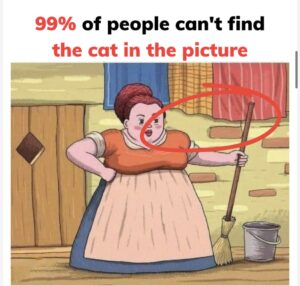The Fascinating World of Optical Illusions: Understanding How Our Eyes and Brain Create Reality
Exploring the science behind visual perception and why our minds sometimes see what isn’t really there
NOTE:THE ANSWER IS AT THE END OF ARTICLE.
Introduction: When Seeing Isn’t Believing
Optical illusions have captivated humanity for centuries, challenging our fundamental understanding of perception and reality. These fascinating visual phenomena occur when our brain interprets information from our eyes in ways that differ from objective reality, creating images that seem to move, change, or appear completely different from what they actually are.
Far from being mere entertainment, optical illusions provide valuable insights into the complex relationship between our visual system and cognitive processes. They reveal the sophisticated mechanisms our brains use to interpret the constant stream of visual information we receive, and demonstrate that perception is not simply passive reception of data, but an active process of interpretation and construction.
The Science Behind Visual Perception
To understand optical illusions, we must first examine how human vision actually works. The process begins when light enters our eyes and strikes the retina, a thin layer of tissue containing millions of photoreceptor cells called rods and cones. These cells convert light into electrical signals that travel through the optic nerve to various regions of the brain, particularly the visual cortex.
However, the journey from light to perception involves much more than simple signal transmission. Our brains must process this raw visual data, filling in gaps, making assumptions, and creating a coherent visual experience from incomplete information. This processing happens so quickly and seamlessly that we rarely notice the complex interpretive work occurring behind the scenes.
The human visual system has evolved to make rapid decisions based on limited information, using shortcuts and assumptions that generally serve us well in everyday life. These mental shortcuts, known as heuristics, help us navigate our environment efficiently but can sometimes lead to perceptual errors that manifest as optical illusions.
Categories of Optical Illusions
Literal Illusions
Literal optical illusions are created by the physical properties of objects or images themselves. These illusions occur when the arrangement of visual elements creates an image that appears different from its component parts. Classic examples include images that can be interpreted in multiple ways, such as the famous duck-rabbit illusion, where a single drawing can be perceived as either a duck or a rabbit depending on how the viewer’s attention is directed.
Physiological Illusions
Physiological illusions result from the overstimulation of specific types of visual receptors in our eyes or neural pathways in our brain. These illusions often involve effects like afterimages, where staring at a bright or colorful object causes us to see a complementary image when we look away. The Hermann grid illusion, where gray spots appear at the intersections of white lines on a black background, exemplifies how our visual system’s attempt to process contrasting information can create phantom images.
Cognitive Illusions
Cognitive illusions occur when our brain’s interpretation of visual information is influenced by our knowledge, expectations, and assumptions about the world. These illusions demonstrate how our previous experiences and mental models shape what we see. The Kanizsa triangle, where we perceive a white triangle that doesn’t actually exist in the image, shows how our brains actively construct meaning from incomplete visual information.
The Role of Context and Expectation
One of the most fascinating aspects of optical illusions is how they reveal the importance of context in visual perception. Our brains constantly use surrounding information to interpret what we’re seeing, and this contextual processing can dramatically alter our perceptions.
The Ebbinghaus illusion perfectly demonstrates this principle. In this illusion, two identical circles appear to be different sizes when surrounded by circles of different sizes. The central circle surrounded by smaller circles appears larger than the identical circle surrounded by larger circles, showing how relative size comparisons influence our perception of absolute measurements.
Similarly, color perception can be dramatically affected by surrounding colors. The same gray square can appear to be completely different shades depending on the background colors surrounding it, revealing that our perception of color is not absolute but relative to the visual context.
Motion and Dynamic Illusions
Some of the most striking optical illusions involve the perception of movement in static images. These motion illusions occur when patterns of light, shadow, and color create the impression of movement where none exists.
The rotating snakes illusion, created by Japanese psychologist Akiyoshi Kitaoka, uses carefully arranged patterns of contrasting colors to create the powerful impression of circular motion in a completely static image. These illusions work by exploiting the slight delays in how different parts of our visual system process information, creating temporal differences that our brain interprets as movement.
Peripheral drift illusions take advantage of the fact that our peripheral vision is less precise than our central vision, creating apparent motion at the edges of our visual field. These illusions demonstrate how our visual system prioritizes detailed processing of central vision while using more general pattern recognition for peripheral areas.
Practical Applications and Benefits
Understanding optical illusions has practical applications across numerous fields. In safety design, knowledge of how visual perception can be deceived helps engineers create better warning systems and hazard identification methods. Road designers use this understanding to create visual cues that help drivers judge speed and distance more accurately.
In the field of camouflage and military applications, optical illusion principles help create more effective concealment techniques. Digital artists and graphic designers regularly employ illusion techniques to create striking visual effects and guide viewer attention in advertisements, websites, and multimedia presentations.
Medical professionals use optical illusions in vision testing and neurological assessments, as changes in how patients perceive illusions can indicate various conditions affecting the visual system or brain function. Researchers studying conditions like dyslexia, autism, and schizophrenia have found that individuals with these conditions sometimes perceive optical illusions differently, providing insights into the underlying neural differences.
Educational Value and Cognitive Development
Optical illusions serve as powerful educational tools that make abstract concepts about perception, neuroscience, and psychology accessible to people of all ages. They provide concrete examples of how our brains work, making complex scientific principles easy to understand and remember.
For children, optical illusions can foster critical thinking skills and encourage questioning of assumptions. They demonstrate that our senses, while generally reliable, are not infallible, promoting healthy skepticism and scientific thinking. Teachers often use illusions to introduce concepts about the scientific method, the importance of measurement and verification, and the distinction between subjective experience and objective reality.
The Future of Illusion Research
Modern technology has opened new frontiers in optical illusion research and creation. Computer graphics and virtual reality systems allow researchers to create increasingly sophisticated illusions that can be precisely controlled and modified for experimental purposes.
Brain imaging technologies such as fMRI and EEG enable scientists to observe neural activity while subjects view optical illusions, providing unprecedented insights into the biological mechanisms underlying perception. This research is contributing to our understanding of consciousness itself, as scientists explore how subjective visual experiences arise from objective neural processes.
Conclusion: Embracing the Wonder of Perception
Optical illusions remind us that reality is more complex and subjective than we might assume. They reveal the remarkable sophistication of our visual system while simultaneously highlighting its limitations and biases. Rather than being flaws in our perception, these illusions represent the inevitable consequences of a system that has evolved to make rapid, generally accurate judgments based on incomplete information.
By studying and appreciating optical illusions, we gain deeper insights into the nature of human consciousness and perception. They encourage humility about the reliability of our senses while inspiring wonder at the complexity and elegance of the human mind. In a world where we are constantly bombarded with visual information, understanding how our brains process and interpret what we see becomes increasingly valuable.
Ultimately, optical illusions serve as beautiful demonstrations of the active, constructive nature of perception. They show us that seeing is not simply receiving information, but rather creating meaning from the complex interplay between our sensory input, cognitive processes, and previous experiences. In this light, every act of perception becomes a small miracle of neural computation and conscious experience.


Sophia Rivers is an experienced News Content Editor with a sharp eye for detail and a passion for delivering accurate and engaging news stories. At TheArchivists, she specializes in curating, editing, and presenting news content that informs and resonates with a global audience.
Sophia holds a degree in Journalism from the University of Toronto, where she developed her skills in news reporting, media ethics, and digital journalism. Her expertise lies in identifying key stories, crafting compelling narratives, and ensuring journalistic integrity in every piece she edits.
Known for her precision and dedication to the truth, Sophia thrives in the fast-paced world of news editing. At TheArchivists, she focuses on producing high-quality news content that keeps readers informed while maintaining a balanced and insightful perspective.
With a commitment to delivering impactful journalism, Sophia is passionate about bringing clarity to complex issues and amplifying voices that matter. Her work reflects her belief in the power of news to shape conversations and inspire change.
